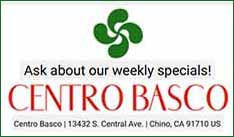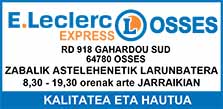by Julie Brown Davis
Mountain Towns Editor.
In the middle of Nevada is a taste of France — specifically, French Basque cuisine. Nestled within Gardnerville, a town on the other side of the Carson Range from Lake Tahoe, is J.T. Basque Bar and Dining Room, a local institution.
A friend and I drove into Gardnerville on a midweek afternoon earlier this month, between the lunch rush and the dinner rush. Besides the passing cars on the main street, the town was quiet, baking beneath the hot August sun. The restaurant is easy to spot. It’s an old white building with a front porch in the middle of town. Red-and-white signs on each side of the building advertise Basque lunch and dinner.
I opened the front door and stepped into what felt like a time capsule: The place feels like a restaurant and saloon that existed decades ago, when ranchers and cowboys slid onto the barstools.
The building itself dates back to the 1870s and the Comstock Lode, originally built in Virginia City. In 1896, it was moved to its Gardnerville location. Eventually, the Jaunsaras and Trounday families — the J and the T of J.T. — turned it into a Basque hotel, saloon and dining hall.
In 1947, Jean Lekumberry left his home in the Basque region of southern France and immigrated to the United States. The 22-year-old landed in the Carson Valley with $32. An uncle helped him find a job as a sheepherder.
By then, Nevada’s Great Basin had a well-established community of Basque people. California’s Gold Rush and then Nevada’s silver Comstock Lode drew the first Basque sheepherders out West. But like many newcomers, rather than pan for gold or venture deep into the earth to mine for silver, Basque immigrants realized a more fruitful path could be found in raising livestock. They established ranches in the Central Valley and in Northern Nevada.
When Lekumberry arrived in Gardnerville, a handful of Basque boarding houses for sheepherders were within a two-block radius of downtown. He found a familiar culture, people who spoke his language and, of course, food that reminded him of home.
In 1960, Lekumberry, with his wife Shirley and his brother Pete, acquired one of those boarding houses: the J.T. Basque Bar and Dining Room. Jean tended bar while Pete worked in the kitchen. Shirley ran the dining room.
More than 60 years later, the restaurant is still family-run, serving family-style Basque meals for lunch and dinner every day save for Sundays. Jean has since died, but Marie-Louise, her brother JM, and their nephew Etienne carry on the tradition.
“Basque food cooked by Basque people but based on ingredients available in the Old West,” said Marie Louise Lekumberry, Jean’s daughter.
Marie Louise, who was born the year her parents purchased the J.T., grew up in the establishment with her two brothers, with a strong sense of Basque culture.
“It was a little Basque world,” Marie Louise said in a phone interview last week. “There were still a lot of immigrants in those days, mostly retired sheepherders who, you know, lived upstairs in the boarding house.”
Marie Louise and her brothers helped their parents in the restaurant, washing dishes or bussing tables. “There was plenty of work to do,” she said.
On the day I visited, a few patrons sat at the bar in the front room talking like people who live in a small town and have known each other for a long time. Over the years, this bar has poured many glasses of Picon punch, a traditional Basque cocktail that originated in the American West, and this summer, it was signed into law as Nevada’s official state drink. It’s made with an aperitif called Amer Picon, a splash of brandy, grenadine, club soda and a twist of lemon.
Back when Jean tended bar, an old rancher would come in for lunch every day and order a Picon punch, Marie Louise told me.
“As gentlemen did in those days, he removed his hat before going into the dining room, and then he would leave and forget it,” she said.
One day, Jean told the rancher that he’d nail his hat to the wall if it was left behind again. Sure enough, the rancher forgot his hat, and Jean mounted it to the wall. That started a J.T. tradition. As I stood in the dining room, I spun around in a full circle to take in all the cowboy hats that once belonged to ranchers in the area and were now nailed to the wall, a tribute to the recent past. Looking up, I saw the ceiling is covered with pinned dollar bills — another parlor trick that caught on.
The dinner hour was still early when we took our seats in the dining room, past the bar. The walls are painted red and have wood paneling, adorned with old photographs of Basque sheepherders and posters from Basque food festivals. The decor really hasn’t changed much over the years, Marie Louise said.
Meals are still served family-style. After we took our seats, the server delivered a small bottle of house red wine, a bread basket and a large bowl of vegetable soup. This was soon followed by a green salad, a plate of beans, a serving of lamb stew and a heaping plate full of fries.
The restaurant used to serve one meal to everyone, but one thing that has changed is the option to choose from a selection of meat-heavy entrees, such as top sirloin steak, lamb shoulder, lamb chops, Basque chicken, pigs’ feet and sweetbread — which is not bread but actually the innards from a calf or lamb. “Basques eat all of the animal,” Marie Louise said.
The food tasted simple and homey. It’s French Basque cuisine but with a dash of Old West thrown in: heavy on the cabbage, meat and potatoes. We ordered the top sirloin and the lamb chops, and our entrees arrived each with a pile of roasted garlic on top. For dessert came coffee and a scoop of ice cream. All of this cost less than $40 a person.
The family-style meal originates from the old boarding houses, Marie Louise said, when sheepherders and town residents all sat at long tables, passing food around and sharing stories. She has fond memories of those convivial meals from a childhood spent growing up in the restaurant.
“Basques are lively people,” Marie Louise said. “Growing up, the town was much more agriculture-based. So there were a lot of cowboys, ranchers, interesting folk around.”
Over the decades, the J.T. has cultivated a loyal, longstanding following of patrons. It’s a combination of locals and visitors. Marie Louise said families often drive down from Tahoe on their summer vacations to come in for a once-a-year visit. People she grew up with as kids now bring their grandchildren.
By the time I’d eaten the last bite of ice cream, my stomach was full, and the dining room had filled up. It was mostly an older crowd, but a few tables sat multiple generations of families. The traditions continue to carry forward: “Just like we are, they are too,” Marie Louise said.



 Lagun bati bidali
Lagun bati bidali Komentarioa gehitu
Komentarioa gehitu








